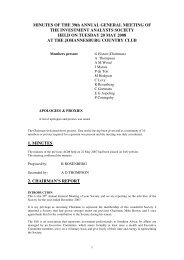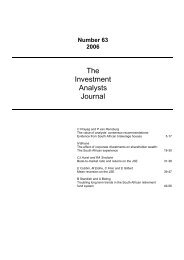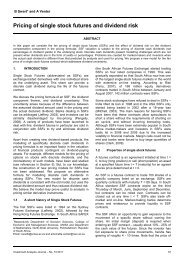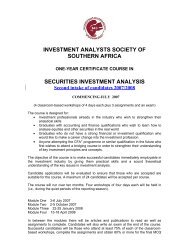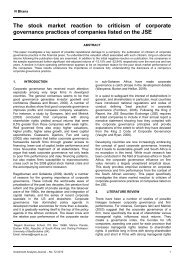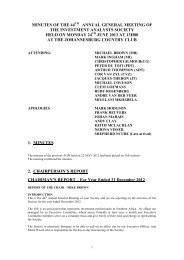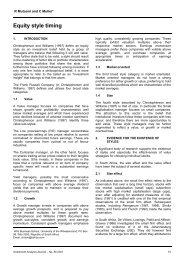Intraday momentum and contrarian effects on the JSE - Investment ...
Intraday momentum and contrarian effects on the JSE - Investment ...
Intraday momentum and contrarian effects on the JSE - Investment ...
You also want an ePaper? Increase the reach of your titles
YUMPU automatically turns print PDFs into web optimized ePapers that Google loves.
<str<strong>on</strong>g>Intraday</str<strong>on</strong>g> <str<strong>on</strong>g>momentum</str<strong>on</strong>g> <str<strong>on</strong>g>and</str<strong>on</strong>g> <str<strong>on</strong>g>c<strong>on</strong>trarian</str<strong>on</strong>g> <str<strong>on</strong>g>effects</str<strong>on</strong>g> <strong>on</strong> <strong>the</strong> <strong>JSE</strong><br />
that large price changes due to excessive overreacti<strong>on</strong><br />
tend be followed shortly <strong>the</strong>reafter by reversals to<br />
more temperate price levels. Our study shows that<br />
this pattern also holds <strong>on</strong> <strong>the</strong> <strong>JSE</strong>.<br />
Returning to <strong>the</strong> results of Table 4, an average gain of<br />
50 basis points per trading day would be sufficient to<br />
treble an investor’s capital over 250 trading days. Do<br />
<strong>the</strong> results <strong>on</strong> <strong>the</strong> <str<strong>on</strong>g>c<strong>on</strong>trarian</str<strong>on</strong>g> strategy imply that this is<br />
actually possible <strong>on</strong> <strong>the</strong> <strong>JSE</strong>? Unfortunately this is not<br />
necessarily <strong>the</strong> case. As noted above, assuming that<br />
returns over <strong>the</strong> holding period can be calculated by<br />
use of <strong>the</strong> mid-quote prices imply that <strong>the</strong> investor<br />
would be able to buy or sell at <strong>the</strong> ruling mid-quote<br />
price at <strong>the</strong> exact moments of <strong>the</strong> start <str<strong>on</strong>g>and</str<strong>on</strong>g> <strong>the</strong> end of<br />
<strong>the</strong> holding period. This is unrealistic as a trading<br />
assumpti<strong>on</strong>. A more realistic assumpti<strong>on</strong> is that<br />
buying <str<strong>on</strong>g>and</str<strong>on</strong>g> selling can be d<strong>on</strong>e instantaneously at <strong>the</strong><br />
ruling ask price <str<strong>on</strong>g>and</str<strong>on</strong>g> bid price respectively. In <strong>the</strong> next<br />
secti<strong>on</strong> we study <strong>the</strong> implicati<strong>on</strong>s of this change in <strong>the</strong><br />
pricing assumpti<strong>on</strong>.<br />
4. EFFECTS OF TRADING AT THE BID AND<br />
ASK PRICES<br />
The <str<strong>on</strong>g>momentum</str<strong>on</strong>g>/<str<strong>on</strong>g>c<strong>on</strong>trarian</str<strong>on</strong>g> trader does not do any<br />
trading over <strong>the</strong> formati<strong>on</strong> period so that use of <strong>the</strong><br />
mid-quote prices to calculate returns over that period is<br />
not questi<strong>on</strong>able <strong>on</strong> trading c<strong>on</strong>siderati<strong>on</strong>s. It is<br />
merely a device to obtain a ranking of <strong>the</strong> stocks so<br />
that losers <str<strong>on</strong>g>and</str<strong>on</strong>g> winners can be identified before<br />
entering into trades over <strong>the</strong> holding period. Therefore<br />
we change <strong>the</strong> pricing assumpti<strong>on</strong> <strong>on</strong>ly for <strong>the</strong> holding<br />
period. We assume that a l<strong>on</strong>g positi<strong>on</strong> in a stock is<br />
acquired at <strong>the</strong> start of <strong>the</strong> holding period at <strong>the</strong> ruling<br />
best ask price <str<strong>on</strong>g>and</str<strong>on</strong>g> terminated at <strong>the</strong> end of <strong>the</strong> holding<br />
period at <strong>the</strong> best bid price ruling <strong>the</strong>n. Similarly, a<br />
short positi<strong>on</strong> is acquired at <strong>the</strong> start of <strong>the</strong> holding<br />
period at <strong>the</strong> best bid price <str<strong>on</strong>g>and</str<strong>on</strong>g> terminated at <strong>the</strong> end<br />
of <strong>the</strong> holding period at <strong>the</strong> best ask price. This implies<br />
that <strong>the</strong> returns of short portfolios are no l<strong>on</strong>ger<br />
necessarily just <strong>the</strong> negatives of those of l<strong>on</strong>g<br />
portfolios <str<strong>on</strong>g>and</str<strong>on</strong>g> we need to track l<strong>on</strong>g <str<strong>on</strong>g>and</str<strong>on</strong>g> short portfolio<br />
returns separately.<br />
Table 5 shows <strong>the</strong> average holding period returns of<br />
<strong>the</strong> l<strong>on</strong>g <str<strong>on</strong>g>and</str<strong>on</strong>g> short portfolios using all stocks when <strong>the</strong><br />
formati<strong>on</strong> period was <strong>on</strong>e hour l<strong>on</strong>g while <strong>the</strong> holding<br />
period durati<strong>on</strong> varied from 1 to 5 hours. The last five<br />
rows of <strong>the</strong> table show <strong>the</strong> differences between <strong>the</strong><br />
returns of <strong>the</strong> l<strong>on</strong>g <str<strong>on</strong>g>and</str<strong>on</strong>g> short portfolios. It is<br />
immediately clear that nei<strong>the</strong>r <strong>the</strong> l<strong>on</strong>g nor <strong>the</strong> short<br />
portfolios were actually profitable under <strong>the</strong> bid-ask<br />
pricing. Hence no combinati<strong>on</strong>s of <strong>the</strong>se can be<br />
profitable ei<strong>the</strong>r. Keep in mind that <strong>the</strong> investor is<br />
faced twice with <strong>the</strong> bid-ask spread, both at <strong>the</strong> start<br />
<str<strong>on</strong>g>and</str<strong>on</strong>g> at <strong>the</strong> end of <strong>the</strong> holding period. To be profitable<br />
with a l<strong>on</strong>g positi<strong>on</strong> <strong>the</strong> end bid price must be larger<br />
than <strong>the</strong> start ask price <str<strong>on</strong>g>and</str<strong>on</strong>g> to be profitable with a short<br />
positi<strong>on</strong> <strong>the</strong> end ask price must be lower than <strong>the</strong> start<br />
bid price. These requirements are not being met often<br />
<str<strong>on</strong>g>and</str<strong>on</strong>g> reliably enough under <strong>the</strong> winner/loser ranking<br />
scheme <str<strong>on</strong>g>and</str<strong>on</strong>g> <strong>the</strong> cost implied by trading at <strong>the</strong> bid-ask<br />
spread overwhelms any possible <str<strong>on</strong>g>c<strong>on</strong>trarian</str<strong>on</strong>g> or<br />
<str<strong>on</strong>g>momentum</str<strong>on</strong>g> profits.<br />
The difference entries still indicate some <str<strong>on</strong>g>c<strong>on</strong>trarian</str<strong>on</strong>g><br />
<str<strong>on</strong>g>effects</str<strong>on</strong>g>. For <strong>the</strong> extreme losers (portfolio 1) <strong>the</strong> l<strong>on</strong>g<br />
choice had higher average returns than <strong>the</strong> short<br />
choice while for <strong>the</strong> extreme winners (portfolio 10) <strong>the</strong><br />
short choice had higher average returns than <strong>the</strong> l<strong>on</strong>g<br />
choice. It was still better to go <str<strong>on</strong>g>c<strong>on</strong>trarian</str<strong>on</strong>g> ra<strong>the</strong>r than<br />
<str<strong>on</strong>g>momentum</str<strong>on</strong>g> <strong>on</strong> <strong>the</strong> extreme ends but unfortunately this<br />
was no l<strong>on</strong>ger profitable <str<strong>on</strong>g>and</str<strong>on</strong>g> <strong>the</strong> investor would be<br />
better off by staying out completely. There are <strong>on</strong>ly<br />
small differences between <strong>the</strong> returns of <strong>the</strong> l<strong>on</strong>g <str<strong>on</strong>g>and</str<strong>on</strong>g><br />
short portfolios for numbers 2 to 9 <str<strong>on</strong>g>and</str<strong>on</strong>g> for <strong>the</strong>se <strong>the</strong><br />
smallest losses occur at 2 <str<strong>on</strong>g>and</str<strong>on</strong>g> 9 while <strong>the</strong> largest<br />
losses occur at <strong>the</strong> neutral portfolio 5. It would be<br />
better to go for <strong>the</strong> mild losers (2 or 3) or mild winners<br />
(8 or 9) ra<strong>the</strong>r than <strong>the</strong> more neutral portfolios (4 to 7)<br />
<str<strong>on</strong>g>and</str<strong>on</strong>g> it matters little whe<strong>the</strong>r taking l<strong>on</strong>g or short<br />
positi<strong>on</strong>s in <strong>the</strong>se cases, but again <strong>the</strong> investor would<br />
be better off staying out completely. The results are<br />
quite similar at <strong>the</strong> o<strong>the</strong>r formati<strong>on</strong> period durati<strong>on</strong>s. In<br />
particular no profitability is achieved in any of <strong>the</strong>se<br />
cases. To save space we do not show <strong>the</strong> details.<br />
Table 6 shows <strong>the</strong> average holding period returns of<br />
<strong>the</strong> l<strong>on</strong>g <str<strong>on</strong>g>and</str<strong>on</strong>g> short portfolios using <strong>on</strong>ly <strong>the</strong> small cap<br />
stocks when <strong>the</strong> formati<strong>on</strong> period was <strong>on</strong>e hour l<strong>on</strong>g<br />
while <strong>the</strong> holding period durati<strong>on</strong> varied from 1 to 5<br />
hours. Here <strong>the</strong> average returns were uniformly more<br />
negative than those of Table 5 where all stocks were<br />
used, but o<strong>the</strong>rwise <strong>the</strong> c<strong>on</strong>clusi<strong>on</strong>s are similar. In<br />
Secti<strong>on</strong> 3 we saw that under mid-quote pricing<br />
investors do better when using <strong>on</strong>ly <strong>the</strong> small cap<br />
stocks ra<strong>the</strong>r than all stocks. Under bid-ask pricing we<br />
find <strong>the</strong> opposite, namely that <strong>the</strong>y do worse. The<br />
primary reas<strong>on</strong> for this is that <strong>the</strong> bid-ask spreads of<br />
<strong>the</strong> small cap stocks tend to be larger than those of <strong>the</strong><br />
large cap stocks as indicated in Table 1, so that buying<br />
<str<strong>on</strong>g>and</str<strong>on</strong>g> selling at <strong>the</strong> bid-ask spread imply greater trading<br />
costs when focusing <strong>on</strong> <strong>the</strong> small cap stocks. This<br />
c<strong>on</strong>clusi<strong>on</strong> is reinforced by Table 7 which shows <strong>the</strong><br />
equivalent results of Tables 5 <str<strong>on</strong>g>and</str<strong>on</strong>g> 6 but with trading<br />
restricted to <strong>the</strong> large cap stocks. In that case <strong>the</strong><br />
average returns are less negative than for <strong>the</strong> small<br />
<str<strong>on</strong>g>and</str<strong>on</strong>g> all stocks cases, although still being unprofitable.<br />
Thus while <strong>the</strong> small cap stocks have larger <str<strong>on</strong>g>c<strong>on</strong>trarian</str<strong>on</strong>g><br />
<str<strong>on</strong>g>effects</str<strong>on</strong>g> for <strong>the</strong> extreme losers <str<strong>on</strong>g>and</str<strong>on</strong>g> winners under midquote<br />
pricing, this advantage is now more than<br />
cancelled out by <strong>the</strong>ir larger implied trading costs due<br />
to <strong>the</strong>ir higher bid-ask spreads. The investor would be<br />
better off trading in <strong>the</strong> large cap stocks although this<br />
is still not profitable.<br />
54 <strong>Investment</strong> Analysts Journal – No. 70 2009




